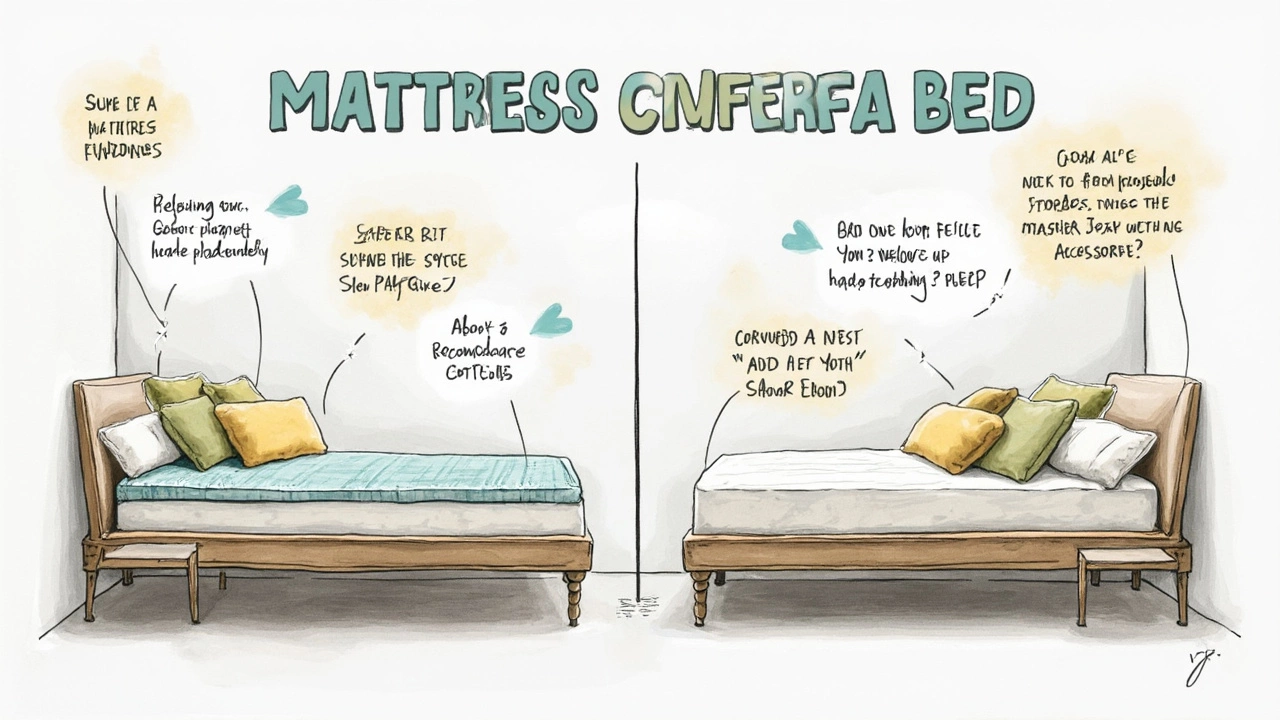
Ever notice how people love to brag about how versatile their sofa bed is—"it's a couch AND a bed!"—but when it comes down to actually sleeping on it every night, there's this shadow of doubt? Let's pull the curtain back on what it's really like living the 'sofa bed lifestyle': the aches, the hacks, the surprises, and some truths that just might change your mind about using your living room as a permanent bedroom.
Back in the day, sofa beds were basically reserved for your cousin who crashed over the holidays or your old college buddy visiting for a weekend. Fast forward to now: with rent prices rocketing, smaller apartments, and the rise of remote work, more folks are turning that foldout into their full-time bed. It’s not just city-dwellers, either. Whether it's saving space, living minimally, or just making do, people everywhere want to know—can you *really* sleep on a sofa bed every night without your back turning into a question mark?
Spoiler: no two sofa beds are created equal. Some are modern engineering marvels, others are back-torture devices masquerading as furniture. Ikea says their Friheten model now outsells traditional couches in some cities, showing that this hybrid lifestyle is actually catching on. And get this: a 2023 survey from Apartment Therapy found that 18% of people under 35 say they sleep on a sofa bed more than three times a week. This isn't just a last-resort sleeping spot anymore.
But does that mean it *should* be your go-to bed? Let's talk reality checks. Yes, you can technically sleep on a sofa bed full time, but if you want to avoid sciatica and actually wake up feeling like a human, you’re going to need to pick wisely and customize a little.
First, a quick breakdown of what makes a sofa bed different from your usual mattress. Standard sofa beds usually fold out into two or three sections, leaving seams right where your back wants smooth support. Under those fabric covers, you’re often looking at a much thinner mattress—usually between 2 and 4 inches thick. Then, instead of slats or a box spring, you're sleeping over a metal frame that’s all sharp bends and hard lines.
Here’s a cool fact: The first patent for a convertible sofa bed showed up in the U.S. in 1899. Since then, not much about the basic design (thin, bendable mattresses for space-saving) has changed for cheaper models. Manufacturers focus more on the couch part being comfy to sit on, leaving the bed part almost as an afterthought. You go from a plush cushion to a barely-there pancake the second you open it up.
By contrast, modern mattresses (memory foam, latex, and hybrids) focus everything on body support, pressure relief, and motion isolation. A standard mattress is between 8-14 inches thick. That’s three times thicker, with way more focus on keeping your spine in a healthy line.
What does that mean for nightly sleep? Lots. The lack of real support, those unavoidable metal bars, and the thin padding all work together to create the worst possible conditions for your joints and muscles. Plus, the gaps and folds mean you’re not really getting even weight distribution—cue the aches and the "I woke up stiffer than I went to bed" feeling.
So, what actually happens to your body if you commit to a sofa bed as your permanent mattress? The answer depends on how good your sofa bed is and how much you tweak it, but let’s break down the big risks:
It’s not all doom and gloom, though. If you pick a high-quality sofa bed—say, a well-built memory foam model—and take steps to fill in the gaps and add cushion, you can bypass most of these issues. But you’ll need to be honest about how much you can (and want to) customize it. We’re talking mattress toppers, special pads, and maybe more pillows than you thought necessary.

All right, let’s say you’re ready to make the leap or you have no choice—limited space, new apartment, roommate situation—here’s how to survive and even thrive on a sofa bed. People have gotten creative with these fixes, so you’re in good company.
Here’s a quick table with sleep comfort ratings (out of 10) reported by real users for different bed setups (source: 2024 Koala Mattress Survey):
| Setup | Comfort Rating | Duration Without Issues |
|---|---|---|
| Basic Sofa Bed (no topper) | 4 | 2-3 days |
| Sofa Bed with 2" Foam Topper | 7 | 7-14 days |
| Sofa Bed with 3" Memory Foam Topper | 8 | Up to 2 months |
| Custom Sofa Bed Mattress | 8.5 | 6+ months |
Notice that extra padding really stretches out how long people can sleep comfortably before reporting aches or sleep disruption. The difference between a basic sofa bed and one with a thick topper is night and day.
You’re probably wondering—does anyone actually recommend sofa beds full time? Believe it or not, there *are* situations where it can make a lot of sense. Tiny studios, micro-apartments in places like Tokyo and New York, or homes with dynamic, multi-use living spaces. Some folks even swear by it for minimalist lifestyles: one piece of furniture, one expense, much more room.
If you invest in a higher-end sofa bed, some come with memory foam, latex, or even hybrid mattresses that rival traditional beds. Big-name brands like Joybird, West Elm, and American Leather offer models with 5-7 inch thick mattresses, built for daily sleep. These run $1,500 and up, but for people who can’t fit a mattress and a couch, it’s worth it.
Another plus: setting up and breaking down a sofa bed daily can actually encourage better habits. You have to remake your bed every morning and evening, which some say helps keep their routine on track and their living space clutter-free. Sleeping in your living room can also offer more airflow and sunlight, which isn’t always a bad thing for sleep quality.
One interesting detail: in Denmark, the "daybed culture" treats foldouts as primary sleep surfaces for decades, just with serious attention to foam quality and supportive frames. It’s all about upgrading your setup, not just tolerating what you’ve got.
Still, not everyone is a good candidate for this lifestyle. If you have chronic back issues, arthritis, or certain joint conditions, a permanent sofa bed setup isn't going to do you any favors—unless you splurge for top-tier models and invest in every support aid available. For most healthy adults, with some effort, daily sofa-bed sleeping can work for a while. But you have to put in that work.
How do you know if your body is reaching its limit with a sofa bed? Look for morning pain that lasts beyond 20 minutes, numbness in your extremities, or a creeping sense of exhaustion that doesn’t go away with days off. These are all warning signs that your bed, sofa or otherwise, isn’t doing the job.
Thinking about the long-term? Don’t ignore new sleep tech—sofa beds keep getting better. Now you can find models with adjustable headrests, built-in USB chargers, hypoallergenic fabrics, and genuinely supportive mattresses. In 2025, the global sofa bed market is expected to reach $5.8 billion, with more people demanding both comfort and function—meaning your average foldout will only get better from here.
Key tip: always test a sofa bed before committing, if you can. A five-minute sit in a showroom isn’t enough. If online, check return policies and customer reviews that specifically mention "used daily". And don’t be shy about swapping the mattress entirely for something custom-made or using heavy-duty toppers. Your body will thank you.
Nightly sofa-bed sleeping is no longer just for couch-surfing friends. With smart choices—like adding a solid topper, using proper supports, and keeping everything clean—you can actually make it work long-term. But don’t fool yourself: your back, neck, and mood all depend on you going that extra mile for comfort. If you do, sleeping on a sofa bed can be more than just a compromise. For some, it’s a surprisingly practical way to live—and yes, even to sleep well every single night.
Write a comment